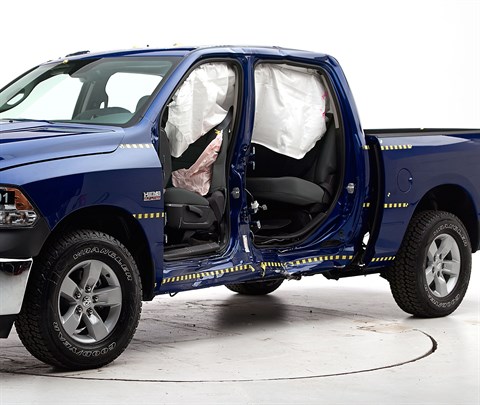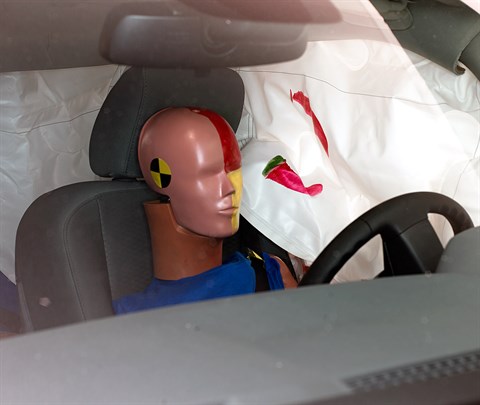Moderate overlap front: original test
Rating applies to 2013-18 models
Tested vehicle: 2009 Dodge Ram 1500 ST Crew Cab 2wd
The Dodge Ram 1500 Crew Cab was redesigned for the 2009 model year. Frontal ratings are assigned by the Institute based on a test conducted by Chrysler. The make name "Dodge" was officially changed to "Ram" beginning with the 2013 model year.
| Evaluation criteria | Rating |
|---|---|
| Overall evaluation | |
| Structure and safety cage | |
| Driver injury measures | |
| Head/neck | |
| Chest | |
| Leg/foot, left | |
| Leg/foot, right | |
| Driver restraints and dummy kinematics | |
Measures of occupant compartment intrusion on driver side
| Evaluation criteria | Measurement |
|---|---|
| Test ID | VTF0815 |
| Footwell intrusion | |
| Footrest (cm) | 11 |
| Left (cm) | 9 |
| Center (cm) | 7 |
| Right (cm) | 4 |
| Brake pedal (cm) | 3 |
| Instrument panel rearward movement | |
| Left (cm) | -1 |
| Right (cm) | -1 |
| Steering column movement | |
| Upward (cm) | 1 |
| Rearward (cm) | -3 |
| A-pillar rearward movement (cm) | 0 |
Driver injury measures
| Evaluation criteria | Measurement |
|---|---|
| Test ID | VTF0815 |
| Head | |
| HIC-15 | 131 |
| Peak gs at hard contact | no contact |
| Neck | |
| Tension (kN) | 1.2 |
| Extension bending moment (Nm) | 42 |
| Maximum Nij | 0.47 |
| Chest maximum compression (mm) | 36 |
| Legs | |
| Femur force - left (kN) | 3.3 |
| Femur force - right (kN) | 0.4 |
| Knee displacement - left (mm) | 2 |
| Knee displacement - right (mm) | 0 |
| Maximum tibia index - left | 0.29 |
| Maximum tibia index - right | 0.26 |
| Tibia axial force - left (kN) | 1.0 |
| Tibia axial force - right (kN) | 1.7 |
| Foot acceleration (g) | |
| Left | 66 |
| Right | 95 |
Side: original test
Rating applies to 2013-18 models
Tested vehicle: 2016 Ram 1500 ST Crew Cab 2wd
The Dodge Ram 1500 Crew Cab was redesigned for the 2009 model year. Beginning with 2009 models manufactured after September 2008, the front door trim panels were modified to improve occupant protection in side impact crashes.
Beginning with 2012 models manufactured after January 2012, side airbags designed to protect drivers' and front passengers' torsos were added to the side curtain airbags previously included. (Information about when a specific vehicle was manufactured is on the certification label typically affixed to the car on the driver door or adjacent B-pillar.)
The make name "Dodge" was officially changed to "Ram" beginning with the 2013 model year.
| Evaluation criteria | Rating |
|---|---|
| Overall evaluation | |
| Structure and safety cage | |
| Driver injury measures | |
| Head/neck | |
| Torso | |
| Pelvis/leg | |
| Driver head protection | |
| Rear passenger injury measures | |
| Head/neck | |
| Torso | |
| Pelvis/leg | |
|
Rear passenger head protection
The side curtain airbag deployed on the wrong side of the dummy's head, before the head had begun to move outward toward the rear passenger door. As a result, the head was hit by the pillar behind the door. This pillar is required by federal standard to provide some protection for occupants' heads. (The window glass, which remained intact during the crash, and the unpadded steel window frame were pulled away from the occupant compartment and did not hit the dummy's head.) | |

View of the vehicle and barrier just after the crash test.

View of the vehicle after the crash with doors removed, showing the side airbags and damage to the occupant compartment.

Smeared greasepaint shows where the driver dummy's head was protected from being hit by hard structures by the side curtain airbag.

The side curtain airbag deployed on the wrong side of the rear passenger dummy's head, and smeared greasepaint shows where the head was hit by the dislodged roof trim. The head was also hit by the pillar behind the rear door.
Measures of occupant compartment intrusion on driver side
| Test ID | CES1601 |
|---|---|
| B-pillar to longitudinal centerline of driver's seat (cm) | -14.0 |
| Negative numbers indicate the amount by which the crush stopped short of the seat centerline. | |
Driver injury measures
| Evaluation criteria | Measurement |
|---|---|
| Test ID | CES1601 |
| Head HIC-15 | 102 |
| Neck | |
| Tension (kN) | 1.0 |
| Compression (kN) | 0.4 |
| Shoulder | |
| Lateral deflection (mm) | 24 |
| Lateral force (kN) | 1.0 |
| Torso | |
| Maximum deflection (mm) | 44 |
| Average deflection (mm) | 38 |
| Maximum deflection rate (m/s) | 3.64 |
| Maximum viscous criterion (m/s) | 0.65 |
| Pelvis | |
| Iliac force (kN) | 2.1 |
| Acetabulum force (kN) | 0.8 |
| Combined force (kN) | 2.8 |
| Left femur | |
| L-M force (kN) | 0.2 |
| L-M moment (Nm) | 28 |
| A-P moment (Nm) | 24 |
Passenger injury measures
| Evaluation criteria | Measurement |
|---|---|
| Test ID | CES1601 |
| Head HIC-15 | 181 |
| Neck | |
| Tension (kN) | 0.2 |
| Compression (kN) | 0.9 |
| Shoulder | |
| Lateral deflection (mm) | 16 |
| Lateral force (kN) | 1.0 |
| Torso | |
| Maximum deflection (mm) | 39 |
| Average deflection (mm) | 28 |
| Maximum deflection rate (m/s) | 4.75 |
| Maximum viscous criterion (m/s) | 0.62 |
| Pelvis | |
| Iliac force (kN) | 0.2 |
| Acetabulum force (kN) | 2.2 |
| Combined force (kN) | 2.4 |
| Left femur | |
| L-M force (kN) | 0.5 |
| L-M moment (Nm) | 70 |
| A-P moment (Nm) | -69 |
Roof strength
Rating applies to 2013-18 models
Tested vehicle: 2011 Dodge Ram 1500 ST Crew Cab 2wd
| Overall evaluation | |
|---|---|
| Curb weight | 5,186 lbs |
| Peak force | 15,412 lbs |
| Strength-to-weight ratio | 2.97 |
Head restraints & seats
Seat type: Power cloth seats
| Overall evaluation | |
|---|---|
| Dynamic rating | |
| Seat/head restraint geometry |
| Seat type | Power cloth seats |
|---|---|
| Geometry | |
| Backset (mm) | 61 |
| Distance below top of head (mm) | 37 |
| Seat design parameters | |
| Pass/fail | Pass |
| Max T1 acceleration (g) | 8.6 |
| Head contact time (ms) | 74 |
| Force rating | 1 |
| Neck forces | |
| Max neck shear force (N) | 21 |
| Max neck tension (N) | 527 |
About the head restraint & seat test
Currently, IIHS tests apply only to front seats.
Child seat anchors
Rating applies to 2014-18 models
| Evaluation criteria | Rating |
|---|---|
| Overall evaluation | |
| Vehicle trim | ST Crew Cab |
| Seat type | cloth |
This vehicle has 2 rear seating positions with complete child seat attachment (LATCH) hardware.
It has 1 additional seating position with a tether anchor only.
| Evaluation criteria | Rating |
|---|---|
| Overall evaluation | |
| Vehicle trim | ST Crew Cab |
| Seat type | cloth |
| Rating icon | Rating |
|---|---|
| G | Good |
| A | Acceptable |
| M | Marginal |
| P | Poor |
| Seating positions that rely on borrowed lower anchors or have only a tether anchor available are not rated. | |
thether anchor symbol | Tether anchor |
lower anchor symbol | Lower anchors |
| Lower anchor(s) can be borrowed from adjacent positions(s) | |
| No hardware available |
Details by seating position
| Position | Rating |
|---|---|
| 1 | |
| Tether anchor | |
| hard-to-find location | |
| other hardware could be confused for anchor | |
| Lower anchors | |
| not too deep in seat | |
| not too much force needed to attach | |
| easy to maneuver around anchors | |
| 2 | |
| Tether anchor | |
| hard-to-find location | |
| other hardware could be confused for anchor | |
| Lower anchors | |
| none available | |
| 3 | |
| Tether anchor | |
| hard-to-find location | |
| other hardware could be confused for anchor | |
| Lower anchors | |
| not too deep in seat | |
| not too much force needed to attach | |
| easy to maneuver around anchors |
Seat position 21
| Lower anchor A | |
|---|---|
| Open access rated | No |
| Depth (cm) | 0-2 |
| Force (lbs) | 26 |
| Clearance angle (degrees) | 67 |
| Lower anchor B | |
| Open access rated | No |
| Depth (cm) | 0-2 |
| Force (lbs) | 15 |
| Clearance angle (degrees) | 71 |
| Tether anchor | |
| Location | Back wall |
| Confusing hardware present | Yes |
| Has contrasting label within 3 inches of tether anchor |
No |
| Tether anchors can be accessed while seatback is properly positioned for use of LATCH |
Not measured |
Seat position 22
| Lower anchor A | |
|---|---|
| No lower latch for this seat position | |
| Lower anchor B | |
| No lower latch for this seat position | |
| Tether anchor | |
| Location | Back wall |
| Confusing hardware present | Yes |
| Has contrasting label within 3 inches of tether anchor |
No |
| Tether anchors can be accessed while seatback is properly positioned for use of LATCH |
Not measured |
Seat position 23
| Lower anchor A | |
|---|---|
| Open access rated | No |
| Depth (cm) | 0-2 |
| Force (lbs) | 10 |
| Clearance angle (degrees) | 83 |
| Lower anchor B | |
| Open access rated | No |
| Depth (cm) | 0-2 |
| Force (lbs) | 24 |
| Clearance angle (degrees) | 77 |
| Tether anchor | |
| Location | Back wall |
| Confusing hardware present | Yes |
| Has contrasting label within 3 inches of tether anchor |
No |
| Tether anchors can be accessed while seatback is properly positioned for use of LATCH |
Not measured |